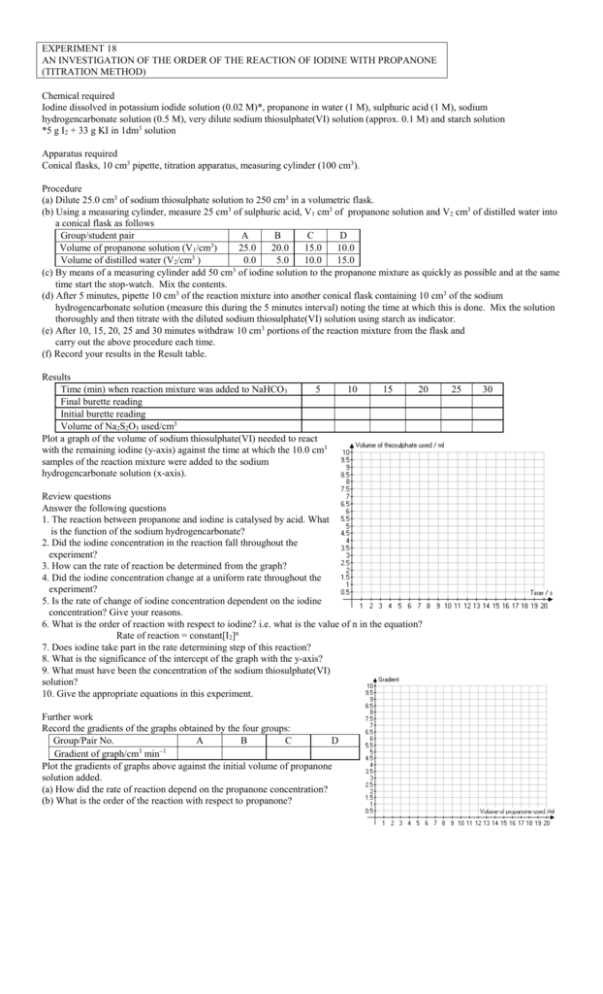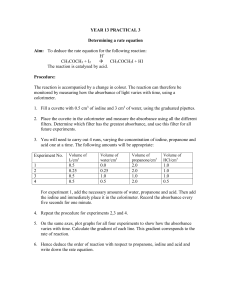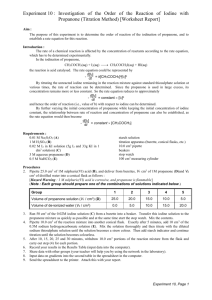EXPERIMENT.
advertisement

EXPERIMENT 18 AN INVESTIGATION OF THE ORDER OF THE REACTION OF IODINE WITH PROPANONE (TITRATION METHOD) Chemical required Iodine dissolved in potassium iodide solution (0.02 M)*, propanone in water (1 M), sulphuric acid (1 M), sodium hydrogencarbonate solution (0.5 M), very dilute sodium thiosulphate(VI) solution (approx. 0.1 M) and starch solution *5 g I2 + 33 g KI in 1dm3 solution Apparatus required Conical flasks, 10 cm3 pipette, titration apparatus, measuring cylinder (100 cm3). Procedure (a) Dilute 25.0 cm3 of sodium thiosulphate solution to 250 cm3 in a volumetric flask. (b) Using a measuring cylinder, measure 25 cm3 of sulphuric acid, V1 cm3 of propanone solution and V2 cm3 of distilled water into a conical flask as follows Group/student pair A B C D Volume of propanone solution (V1/cm3) 25.0 20.0 15.0 10.0 Volume of distilled water (V2/cm3 ) 0.0 5.0 10.0 15.0 (c) By means of a measuring cylinder add 50 cm3 of iodine solution to the propanone mixture as quickly as possible and at the same time start the stop-watch. Mix the contents. (d) After 5 minutes, pipette 10 cm3 of the reaction mixture into another conical flask containing 10 cm3 of the sodium hydrogencarbonate solution (measure this during the 5 minutes interval) noting the time at which this is done. Mix the solution thoroughly and then titrate with the diluted sodium thiosulphate(VI) solution using starch as indicator. (e) After 10, 15, 20, 25 and 30 minutes withdraw 10 cm3 portions of the reaction mixture from the flask and carry out the above procedure each time. (f) Record your results in the Result table. Results Time (min) when reaction mixture was added to NaHCO3 5 Final burette reading Initial burette reading Volume of Na2S2O3 used/cm3 Plot a graph of the volume of sodium thiosulphate(VI) needed to react with the remaining iodine (y-axis) against the time at which the 10.0 cm3 samples of the reaction mixture were added to the sodium hydrogencarbonate solution (x-axis). 10 15 20 Review questions Answer the following questions 1. The reaction between propanone and iodine is catalysed by acid. What is the function of the sodium hydrogencarbonate? 2. Did the iodine concentration in the reaction fall throughout the experiment? 3. How can the rate of reaction be determined from the graph? 4. Did the iodine concentration change at a uniform rate throughout the experiment? 5. Is the rate of change of iodine concentration dependent on the iodine concentration? Give your reasons. 6. What is the order of reaction with respect to iodine? i.e. what is the value of n in the equation? Rate of reaction = constant[I2]n 7. Does iodine take part in the rate determining step of this reaction? 8. What is the significance of the intercept of the graph with the y-axis? 9. What must have been the concentration of the sodium thiosulphate(VI) solution? 10. Give the appropriate equations in this experiment. Further work Record the gradients of the graphs obtained by the four groups: Group/Pair No. A B C D Gradient of graph/cm3 min1 Plot the gradients of graphs above against the initial volume of propanone solution added. (a) How did the rate of reaction depend on the propanone concentration? (b) What is the order of the reaction with respect to propanone? 25 30






